This article discusses some of the sanding technology innovations that are helping workshops to achieve consistently high quality finishing of veneered and painted panels - including the holy grail that is the mirror finish - whilst improving paint economy and workflow efficiency.
The key to a flawless surface finish is in the preparation. With the right choice of sander, manufacturers might even come to love high gloss almost as much as their customers do.
Sanding basics
The sander comes into play at several stages in the painted panel production process. The first is for calibration of the panels to ensure they are all of identical thickness. Next, panels are pre-sanded to prepare the surface for painting. Panels are sanded again after the base coat or primer is applied, which can be repeated if required. After the top coat is applied, a final sanding operation might be needed if a buffing gloss finish is required. Each of these stages will require a different sanding belt and might require a different type of sanding unit.
What’s more, each stage might require more than one belt or more than one unit. For example, if sanding a very rough panel up to a 320 grit finish (the typical finish for a veneered panel), this cannot be done in one pass; it will need to be done using a series of progressively finer grit belts: you might start with an 80 grit belt, followed by a 120, then 180, before reaching the final stage of sanding with a 240 grit belt. This sequence might require some belt changes depending on the number of sanding units in your machine. The more sanding units within a machine, the fewer belt changes needed.
This example demonstrates the challenge facing machine designers: to build sanders that are highly customisable and flexible. At the same time, they need to make it easier for workshops to achieve the quality of finish that the market demands - whatever paint they are using. To this end, Biesse, a pioneer in the sanding technology market, has conceived a number of innovations that were designed with this as their common goal.
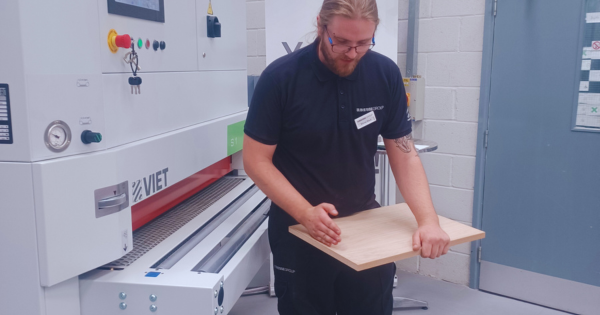
Segmented electronic pad: zonal sanding
The technology that is arguably most fundamental to achieving a flawless finish is the electronic segmented pad. This pad eliminates the risk of over-sanding on areas such as corners and edges where it is very easy to accidentally sand through coating layers.
The principle behind using a pad rather than a roller is that the contact area is much larger. This means that far less pressure is applied to the panel than when using a roller. Most basic pads are pneumatic, which are inexpensive, easy to use and able to achieve a good finish on solid wood. However, they do have limitations: there is no side control and limited pressure adjustment. Biesse has addressed these limitations through the development of a patented electronic pad that offers greater scope to control and adjust the sanding process. The contact pad is divided into individually controlled sections, giving users the option to be selective over where pressure is applied to the panel.
Generally with veneer or painted panels, no matter how good a job is done in the spraying booth, there will inevitably be less paint along the sides than on the middle of the panel. The danger with those areas where the layer is thinner is that the sander will go through to bare wood.
With the electronic pad, a reading bar detects the shape and profile of the panel and activates the corresponding segments of the pad. In this way, it is possible to achieve maximum precision on edges and curved shapes, which is ultimately the key to achieving an even finish.
Corners are a particularly critical area when it comes to the issue of over-sanding, which is why Biesse has developed a ‘Save Corner’ function within the electronic pad. The machine auto-detects the corners of the panel and reduces the sanding accordingly in the set areas to prevent the sander from going through the veneer or paint.
For high gloss panels, which require the painted surface to be absolutely flat if a mirror finish is to be achieved, the electronic pad really comes into its own. This is possible thanks to the use of pressurised air that gives greater control when compared to purely electronic systems. Sanding can be further adjusted by varying the amount of pressure that is applied across the different segments.
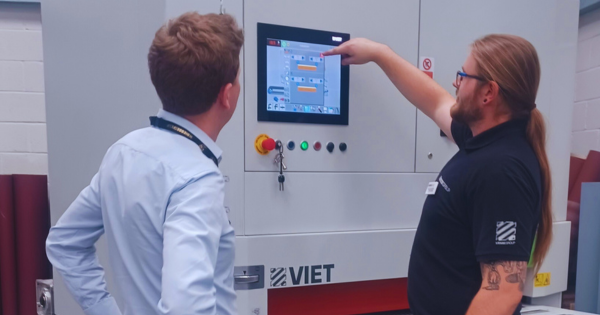
Superfinishing unit: for the ultimate surface finish
In an evolution of the electronic pad, Biesse has developed a superfinishing unit for the ultimate surface finish. The superfinishing unit is based on the segmented electronic pad with the addition of a chevron belt between the sanding belt and the panel. The chevron belt is comprised of soft felt strips that enable it to follow the contours of the panel even more closely, giving a superior, uniform finish on flat panels. In addition, because sanding belt temperature increases due to friction whilst sanding, the presence of the chevron belt helps to keep the sanding belt cool. This prolongs the lifetime of the sanding belt and eliminates quality issues that can arise from overheating. Both the electronic segmented pad and superfinishing unit will compensate for +/-1mm if the core of the panel and veneer are not perfectly calibrated.
Cross working: the clever configuration
When high gloss finishing is the goal, Biesse recommends opting for a cross unit rather than a conventional working unit. The cross unit has the superfinishing technology at its core, but the sanding belt moves cross-wise in relation to the panel feeding direction. This is the best configuration to achieve a flat finish with high grits from 600 to 1200 because these very fine grits tend to clog the belt and the transversal action prevents this from happening. It will even guarantee flatness on polyester painted panels, which can be challenging to achieve.
The cross unit works equally well as an aggressive low grit unit, to ensure the surface is flat before applying paint. Its flexibility means the cross unit can either be the first sanding unit in the workflow or the fine finishing unit.
The cross unit has other uses too, such as removing glue from veneer panels. Residual glue lines are problematic on veneer panels as they quickly clog up the sanding belt, causing defects in the process and resulting in belts having to be discarded. The transversal action means that the clogged area of the belt will immediately be followed by a clean area, preventing defects. Similarly, if there is any pigmentation of the paint it won’t mark the sanding belt or the panel; the cross working means it will just disappear from the belt.
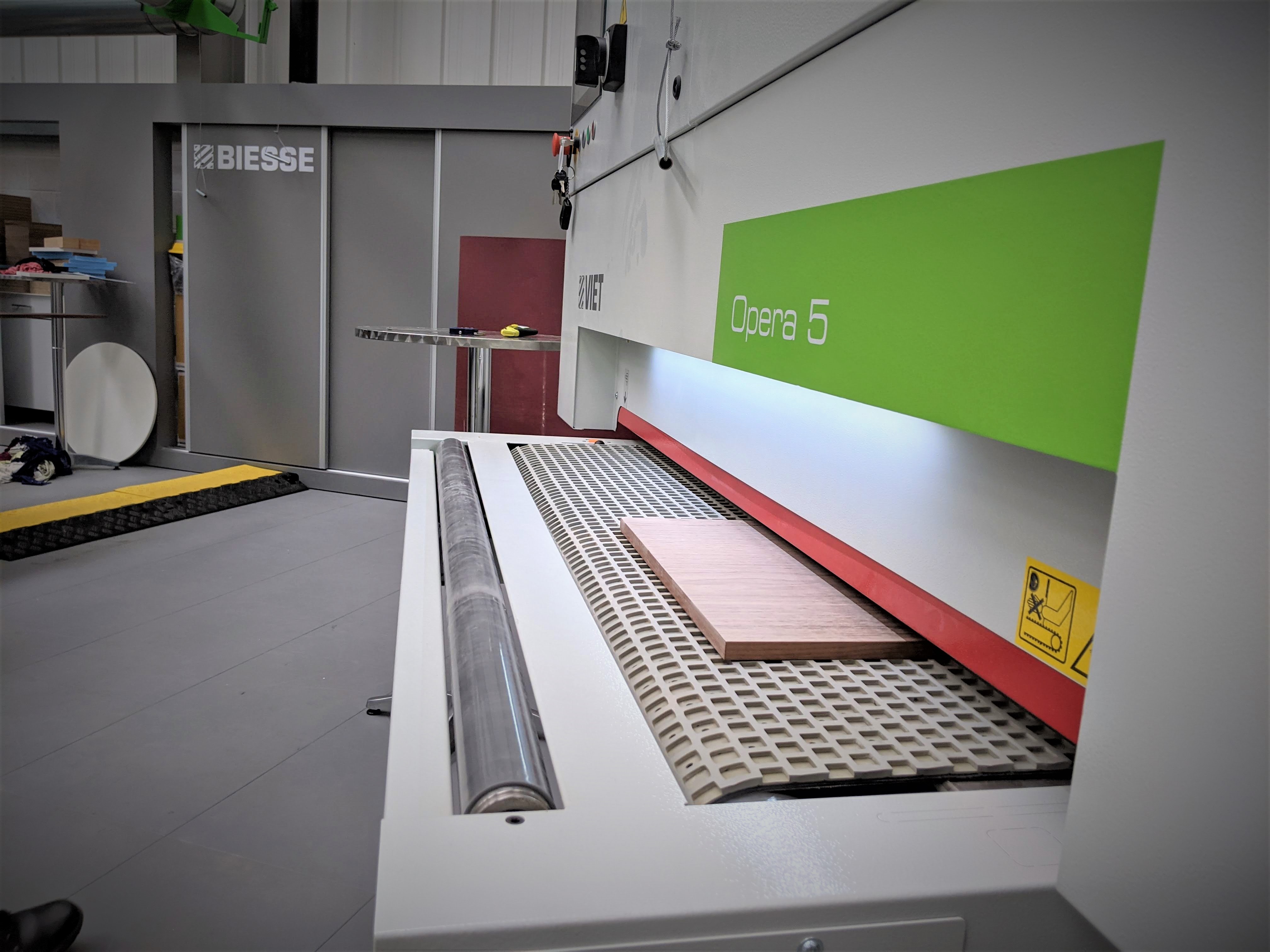
Brushing units: getting into the groove
However, not all panels are flat in their design - routed shaker style panels or recessed panels may require a different treatment. Here, a brush is the best option. Sanding is performed using abrasive brushes fitted with strips that flex to get into recesses. Biesse also offers an X-Spin brushing unit that sands in different directions to give a homogeneous finish on a wide variety of profiles. This unit incorporates five rotating heads, each equipped with three brush discs. The entire unit travels from side to side whilst every single disc rotates clockwise, apart from one group of three discs, which rotate in an anti-clockwise direction. This counter-movement helps to cover all areas of the panel.
Combination units: save space and money
Whilst it is desirable for most workshops to have all of these units included within their sanding machine, it is not usually practical, for space and budgetary reasons. Here’s where combination units come into play. By enabling both a roller and a pad to be incorporated into one working unit, they offer a very versatile solution. A typical example might be where a manufacturer ideally wants to have a hard or soft roller followed by a second pass with a pad. A combination unit incorporating a roller and a pad will give both units within the space normally dedicated to one unit.
Designed with veneer, lacquer and basecoat finishing in mind, Biesse’s Viet Sanders offer a highly customisable sanding platform. They can be configured with combinations of different rollers, pads and brushes plus accessories like a Scotchbrite roller, a blower and a structuring brush at the outfeed.
Explore the full range of sanding machines here.


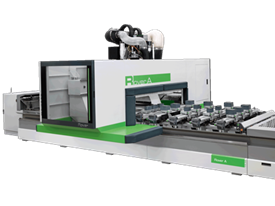
.png)
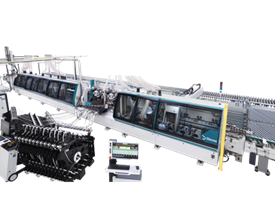
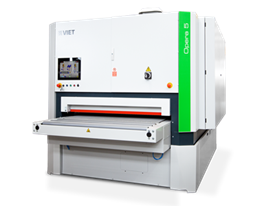
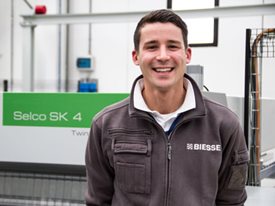
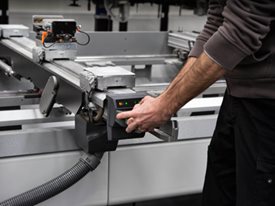

 Worldwide
Worldwide
 Italia
Italia
 United Kingdom
United Kingdom
 Россия
Россия
 France
France
 中国
中国
 Asia
Asia
 Deutschland
Deutschland
 España
España
 Schweiz
Schweiz
 North America
North America
 India
India
 Australia & New Zealand
Australia & New Zealand
 Türkiye Cumhuriyeti
Türkiye Cumhuriyeti
 Middle East
Middle East
 Brasil
Brasil